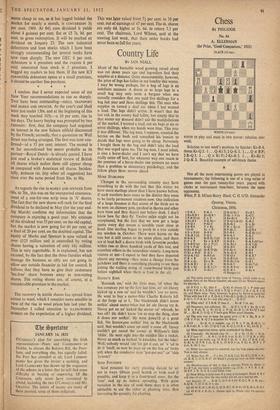Chess
BY PHILIDOR
No. 84 A. ELLERMAN (1st Prize, 'Good Companions,' 1921) BLACK (10 men'
WHITE (10 men)
wiirre to play and mate in two moves: solution next week.
Solution to last week's problem by Sparke: Kt-B 4, dur,at Kt-Q 3. 1 ...Q-Kt 5; 2 Q-K 5. 1 ...Q x BP; 2 R-Q 5. 1 . Q x Kt P; 2 Kt-R 3. 1 . Kt-Kt 5; 2 Q-K 3. Beautiful example of self-block theme.
Not all the most entertaining games are played in tournaments; the following is one of a long series of games over the past twenty-five years, played with clocks at tournament time-limit, between the same opponents.
White, P. S. Milner-Barry Black, C. H. O'D, Alexander Opening, Vienna. Christmas, 1956.
t P-K 4 P-K 4 22 R-Q Kt 3 Kt-B 3
2 Kt-Q B 3 Kt-QB 3 23 Kt x P ob K-Q 2
3 P-B (a) P P 24 Kt-Kt 4 Kt x P 4 Kt-B 3 P-K St 4 25 R-Q 3 ch (k) K-K 2 'P-Kt 5 Kt
P x Kt 26 R-K 3 27K x Ktcb R x K-Q 2
7 0-0 Kt x P! 28 P-Kt 3 R-Q B 4 8 B x P(b) B-13 4! 29 P-B 4 R-K Kt 1 (t) 9 K-R 1 (c) P-Q 3 30 B-K 5 R-K I 10 B-K 3 B-K Kt 5 (d) 31 R-Q 4 ch K-B 3 II P x P Kt x K B P 32 B-B 4 R-K 8 cht(m) 12 B-B 41 (a) Kt x P (f) 33 K-Kt 2 R-K 7 ch 13 B x P chOr QK-Q 2 34 K-B 3 R x RP 14 Kt-R 41 -R 35 P-Kt 4 R-B 4 15 Kt x B ch) K-K 25? (A) 36 K-Kt 4 R-B 2 16 Q-K 1 (1) Q B-B Qch 37 R-Q S R-K B 7
R x
17B x 38 B 5 ch K-Kt 2 18 R x Q Kt x Rch R- 39 R-Kt 5 ch K-131 19 R-K B 1 K x B 40 B-K S R-Kt 7 ch 20 R x Kt K-K I (I) 41 K-R 4 (n) R-B 8 21 Kt x P R-Kt I 42 K-R 3 R-Kt 4 43 Resigns (o) (a) Not quite sound in this form of Vienna, which leads to an inferior form of the Muzio Gambit; see note (b) for White's reason for playing it.
(b) If 8 Q x Kt, then 8 . . . Q-Kt 41 (threat Q x P mate and B-B 4); 9 R-B 2 13-B 4; 10 11 x P, Q x P ch!: 11 R x Q, B Q ch; and Black wins. Text, however, is given by Keres as good for White with line 8 B x P. Q-B 3; 9 Kt-Q 5, Q-Kt 2; 10 Kt x P eh,
K-Q I; II P-K Kt 31—but why play 8 Q-B 3?
(c) What else? If 8 B-K 3? then 8 Kt-K 7 ch, etc.
(d) Neemary, but sufficient. 10 ... Q-B 3; B x Kt, Q x B; 12 8 x P ch, K x B; 13 Q x P ch, Kt-h 3; 14 Kt-Q 5 and 10 ... Kt-K 3; 11 Q x P both give White good chances.
(e) The only way to keep the game alive 12 R x B x 13 8 x P ch, K-Q 2 is hopeless ihr White.
(J')12 . . . Kt-K 4; is simpler, e.g. 13 B x P ch, K-Q 2; la B-K 6 chi, K x 131; 15 Qt-Q 5 ch, K-Q 2; 16 B x Kt, Kt- K 2! (2) Most ingenious move, quite overlooked by Black. (4) Cowardly. He should play 14. . • x Q; IS Kt x B ch,
K-B 31 (not 15 . K-B 1; 16 B-K 6 ch, K-Kt 1; 17 K R x 131);
and there is no mate, e.g. 16 B-Q 5 ch, K x Kt; 17 B-K 3 cll. K-Kt 4; 18 P-R 4 ch, K-R 3; 19 B-B 4 ch, P-Kt 4; 20 P x P
d.ch, 2, etc.
(1) White has regained his material, but has four pieces en prise. Text is only chance. (I) Better than 20 ... P x Kt; 21 13-K 5 ch. Kt-B 3; 22 R X K' ch, K-K 2; 23 13-13 61 All Black's pieces are now on their original squares! (k) Disadvantage of this Is that it exposes White to threat 01 Kt-8 7 ch, but there is nothing better, e.g. 25 Kt x B P, R x R, 26 B P X R, R-K B 1 and Black wins. (/) Now White Is quite lost; if a rook is exchanged, Meek K R will win—if not, then the two rooks will set up a mating net (m) Simpler, 32 R-K 7; 33 P-R 4 (33 R-Q 2, R x R. etc.) R-Q Kt 7 ; 34 kt-K B 4, cic.
(n) Or 41 K-R 3, R-Kt 3; 42 R-B 5, R-11 41; 43 K-R 4, R-B 8.
(o) 43 K-R 4. R-Kt 3. Heroic fight by White after his opening disaster


































 Previous page
Previous page